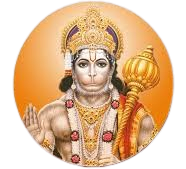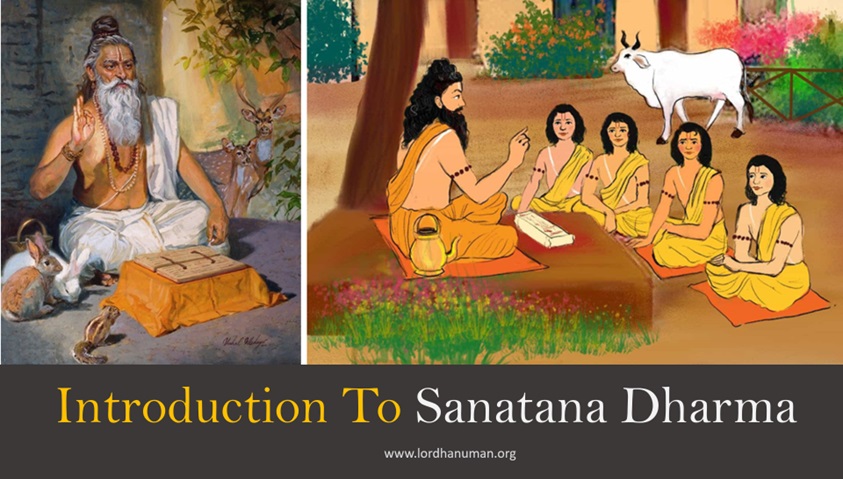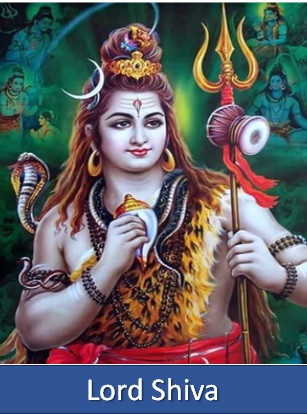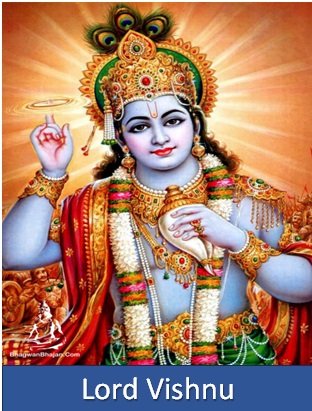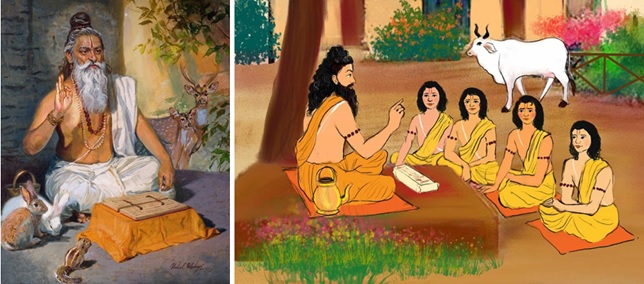
Sanatana Dharma
सनातन धर्म
Hindu Religion
Hinduism
Sanatana Dharma, often referred to as Hinduism, is an ancient religious and philosophical tradition with a rich history and a diverse set of religious scriptures.
Sanatan Dharma, also spelled Sanatana Dharma and often referred to as Hinduism, is a complex and ancient religious and philosophical tradition with a rich history and a diverse set of religious scriptures.
The word ‘sanatana’ has its roots in Sanskrit, which can be translated into “eternal”, “ancient”, “venerable”, or “unshakeable”. Hence, ‘Sanatan Dharma’, as per popular Hindu beliefs, is a religion that has existed since time immemorial.
Sanatana Dharma encompasses numerous symbols, some of which include: The Om symbol: Om is a sacred syllable representing the divine. It also symbolises the three gunas—sattva (purity), rajas (activity), and tamas (inertia).
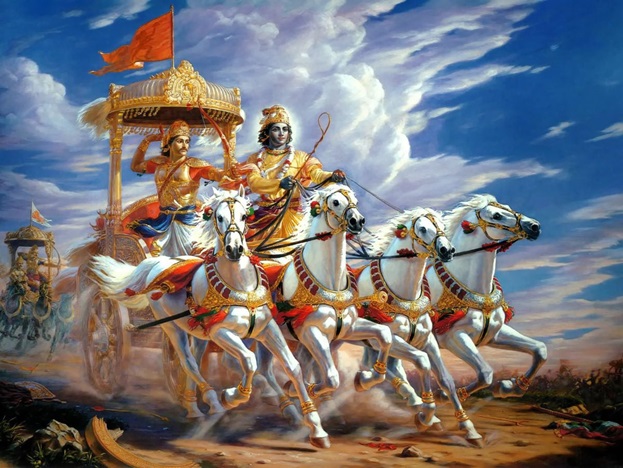
The origins of Sanatana Dharma are deeply rooted in the Indian subcontinent. It’s challenging to pinpoint a specific date for its beginning, as it has evolved over thousands of years.
About 6,000 years ago, there was only one religion in the whole world, whose name was Sanatana Dharma, also called Vedic Religion. The simple meaning of the Sanatan Vedic religion was to live life in the manner described in the Vedas.
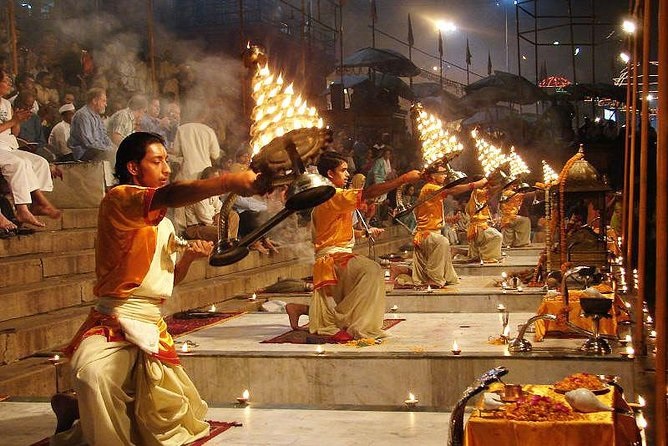
The origins of Sanatana Dharma are deeply rooted in the Indian subcontinent. It’s challenging to pinpoint a specific date for its beginning, as it has evolved over thousands of years. Sanātana has a range of meanings, including ‘eternal,’ ‘everlasting,’ ‘perpetual,’ ‘permanent,’ ‘primeval,’ and ‘ancient. ‘ Dharma can mean ‘law,’ ‘duty,’ ‘righteousness,’ ‘virtue,”morality,”religion,’.’ ‘morality,’ ‘religion,’ .
Sanatan Dharma philosophy and practices are based on many comprehensive, well-documented religious scriptures. These religious texts, along with countless others, provide a comprehensive framework for understanding the philosophy, rituals, and cultural aspects of Sanatana Dharma.
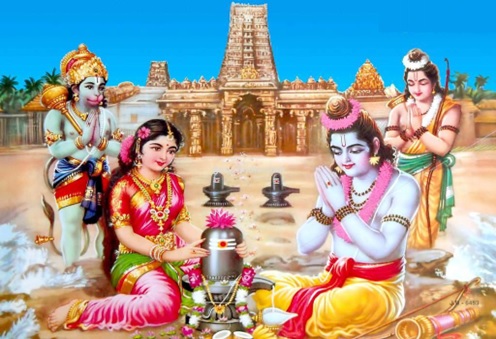
It is a tradition known for its depth and diversity, allowing individuals to explore various paths to spirituality and self-realization.It is a tradition known for its depth and diversity, allowing individuals to explore various paths to spirituality and self-realization.
This article attempts to capture the essence of Sanatan Dharma and provide an overview of its origin, history, and key religious texts.
Origin Of Sanatana Dharma
The origins of Sanatana Dharma are deeply rooted in the Indian subcontinent. It’s challenging to pinpoint a specific date for its beginning, as it has evolved over thousands of years. However, scholars trace its roots to the following:
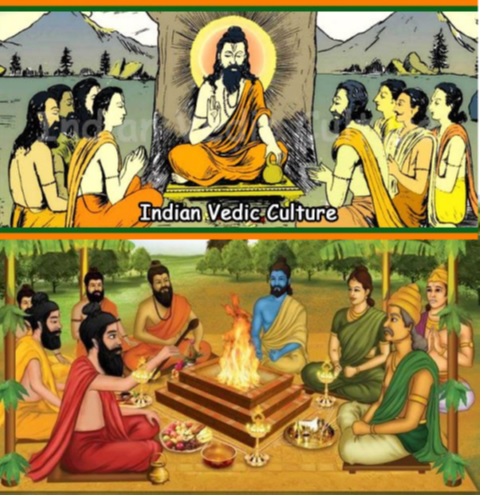
Vedic Period
Sanatana Dharma has its early origins in the Vedic period, which dates back to around 1500 BCE. The Vedas, a collection of ancient sacred texts, serve as the foundational scriptures of this tradition. The Vedas include the Rigveda, Yajurveda, Samaveda, and Atharvaveda.
Indus Valley Civilization
Some practices and symbols from the Indus Valley Civilization, which existed around 3300–1300 BCE in what is now Pakistan and northwest India, are believed to have influenced early Hindu culture.
Evolution of Beliefs
Over centuries, Sanatana Dharma absorbed and synthesized various religious and philosophical ideas. This resulted in a diverse and inclusive religious tradition that accommodates multiple beliefs and practices.
History Of Sanatana Dharma
Sanatan Dharma, often referred to as Hinduism, is one of the world’s oldest religions, with a history spanning over 4,000 years. It is a complex and diverse belief system rooted in the Indian subcontinent.
Sanatan Dharma emphasizes the concepts of karma, dharma, and reincarnation. It encompasses a wide range of beliefs, practices, and rituals, including devotion to deities, meditation, and yoga.
Over the centuries, it has evolved through the Vedas, Upanishads, epics like the Ramayana and Mahabharata, and the teachings of spiritual leaders such as Buddha and Shankaracharya. It remains a vibrant and enduring faith, deeply intertwined with Indian culture and spirituality.
Sanatana Dharma’s history can be divided into various periods and developments:
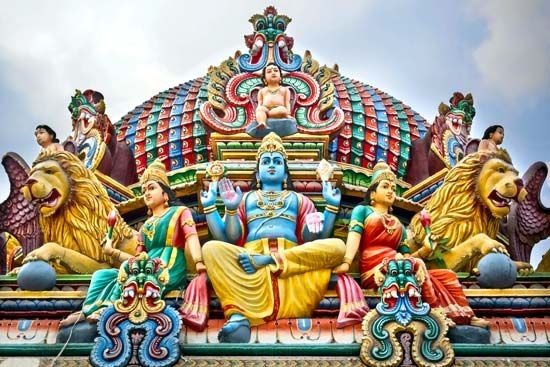
- Vedic Period (1500–500 BCE): This period laid the foundation for many core beliefs and practices of Sanatana Dharma. The Vedas and rituals were central during this time.
- Upanishadic Period (800–200 BCE): The Upanishads, which are considered the culmination of Vedic thought, introduced philosophical concepts such as karma, dharma, and moksha (liberation).
- Epic Period (500 BCE–400 CE): The two major epics, the Mahabharata and the Ramayana, emerged during this period. These narratives played a crucial role in shaping Hindu beliefs and values.
- Classical Period (400–1200 CE): This era saw the development of various schools of philosophy, including Vedanta, Samkhya, Nyaya, and Yoga. Temples were constructed, and devotional practices became more prominent.
- Medieval and Bhakti Movements (800–1700 CE): The medieval period brought about the Bhakti and Sant movements, emphasizing devotion to a personal deity and social inclusiveness.
- Colonial Period (18th and 19th centuries): Hinduism was influenced by British colonialism, which had both positive and negative effects on the tradition. The period also witnessed reform movements aimed at addressing social and religious issues.
- Modern Period (20th century to the present): Hinduism continues to evolve in response to contemporary challenges. It has a global presence with followers around the world.
Religious Scriptures Of Sanatana Dharma
Sanatana Dharma’s religious scriptures are vast and diverse, encompassing texts like the Vedas, Upanishads, Bhagavad Gita, Ramayana, and Mahabharata. The Vedas are the oldest, with Rigveda as the foundational text. Upanishads delve into spiritual philosophy.
The Bhagavad Gita, a part of the Mahabharata, is a revered dialogue on duty and ethics. The Ramayana narrates Lord Rama’s life and values, while the Mahabharata includes teachings, including the epic of the Kurukshetra War.
Further, the Puranas, Manusmriti, and various Sutras provide guidance and narratives. These scriptures offer profound insights into spirituality, morality, and the diverse traditions of Sanatana Dharma.
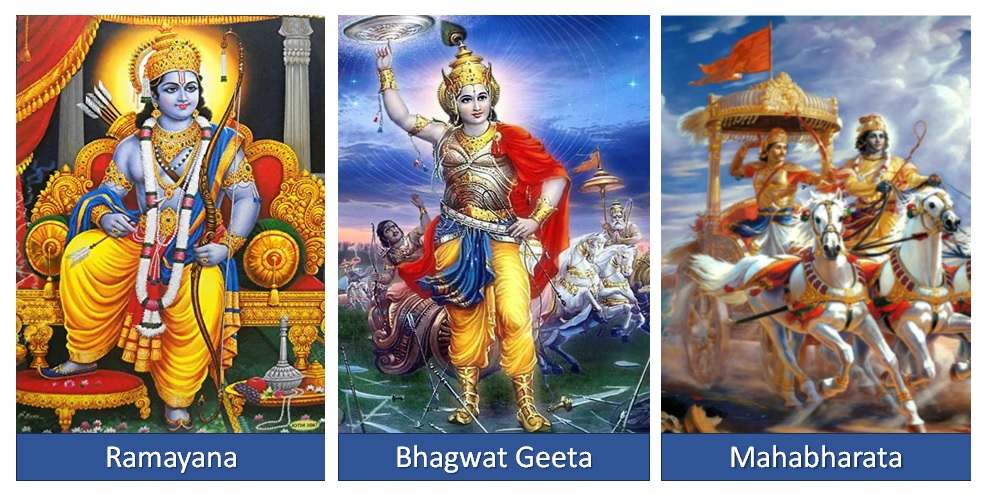
- Vedas: The four Vedas (Rigveda, Yajurveda, Samaveda, Atharvaveda) are the oldest and most authoritative texts in Hinduism. They consist of hymns, rituals, and philosophical discussions.
- Upanishads: These texts explore profound philosophical concepts and are often considered the concluding part of the Vedas.
- Bhagavad Gita: Part of the Mahabharata, this scripture contains a conversation between Prince Arjuna and Lord Krishna, covering topics of duty, ethics, and spirituality.
- Ramayana: An epic narrative that tells the story of Lord Rama, his exile, and his quest to rescue his wife, Sita.
- Mahabharata: One of the longest epics in world literature, it contains the Bhagavad Gita and a vast array of stories and teachings.
- Puranas: These are a genre of texts that contain myths, legends, and religious narratives. There are 18 major Puranas, including the Vishnu Purana and Shiva Purana.
- Dharma Shastras: Texts like the Manusmriti and Yajnavalkya Smriti provide guidelines on law, ethics, and social duties.
- Agamas and Tantras: These texts are particularly important for temple rituals, architecture, and iconography.
- Bhakti Literature: Works by saints and philosophers, such as the poems of Mirabai and Tulsidas, emphasize devotional worship.
Revered Deities Of Sanatana Dharma
Hinduism is a diverse and ancient religion with a multitude of deities. These are just a few of the many deities in Hinduism. Hindu worship can vary greatly, with devotees choosing particular deities to focus on based on personal preference, tradition, or specific needs and aspirations.
The diverse pantheon of Hindu deities reflects the rich tapestry of beliefs, rituals, and philosophies within the religion. Some of the major deities in Hinduism include:
- Brahma: The creator of the universe, often depicted with four faces, each representing one of the four Vedas.
- Lord Vishnu: The preserver of the universe, who takes various incarnations (avatars) to restore dharma (righteousness) whenever it is threatened.
- Lord Shiva: The destroyer and transformer, who represents the cycle of creation, preservation, and destruction. He is also the Lord of meditation and asceticism.
- Devi (Goddess Shakti): The divine feminine energy and the source of all power. She is worshiped in various forms, including Durga, Kali, and Parvati.
- Lakshmi: The goddess of wealth and prosperity, often depicted with lotus flowers and coins.
- Saraswati: The goddess of knowledge, arts, and music, associated with the river of the same name.
- Ganesha: The elephant-headed god of wisdom, knowledge, and the remover of obstacles.
- Lord Hanuman: The monkey god known for his devotion and strength, a prominent figure in the Ramayana.
- Krishna: An avatar of Vishnu, known for his role in the Mahabharata and the Bhagavad Gita, and as a divine lover and playful child.
- Lord Rama: Another avatar of Vishnu, revered for his adherence to dharma, as depicted in the Ramayana.
- Surya: The sun god, considered the source of life and illumination.
- Goddess Kali: The fierce and powerful goddess who represents time and change, often depicted with a garland of skulls.
- Lord Murugan (Kartikeya): The god of war and victory, often depicted with a peacock as his mount.
- Yama: The god of death and justice, who determines the fate of souls after death.
- Varuna: The god of cosmic order, water, and the oceans.
- Agni: The god of fire, representing the divine purifying force.
- Dhanvantari: The god of medicine and the physician of the gods.
- Sita: The goddess of virtue, who is the consort of Lord Rama.
- Radha: The beloved of Lord Krishna, often worshiped alongside him.
- Dattatreya: A deity who embodies the trinity of Brahma, Vishnu, and Shiva, revered as a guru and healer.
Difference Between Sanatana Dharma And Hindu Religion
“Sanatana Dharma” and “Hinduism” are terms that are often used interchangeably to refer to the religious and spiritual traditions originating in the Indian subcontinent. , “Sanatana Dharma” is a broader, philosophical term emphasizing the eternal and universal aspects of Indian spirituality.
Whereas “Hinduism” is a more specific term often used to describe the organized religious traditions within this broader framework. Both terms, however, refer to the rich tapestry of spiritual and religious practices that have evolved in the Indian subcontinent over millennia.
Both of these terms are two sides of the same coin. However, there is a subtle difference in how these terms are understood:
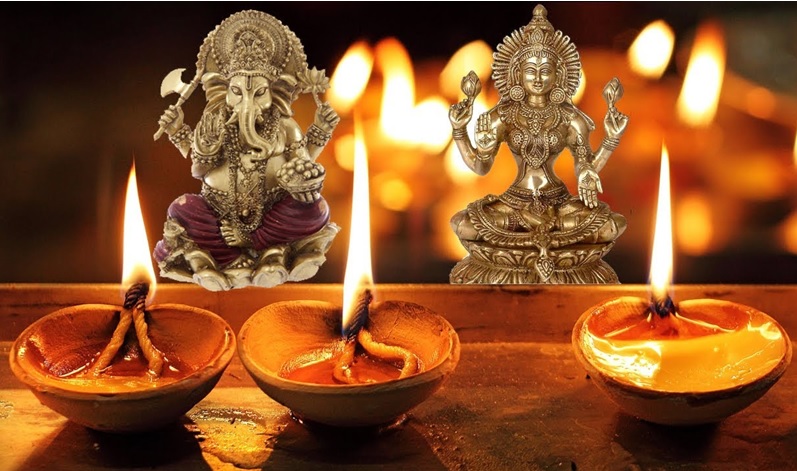
Sanatana Dharma
- Sanatana Dharma translates to “Eternal Dharma” or “Eternal Religion.” It is a more inclusive and philosophical term that encompasses the entire spectrum of Indian spiritual and religious traditions. It emphasizes the timeless, universal principles and practices that underlie these traditions.
- Sanatana Dharma is not limited to a specific set of beliefs or practices but is considered a way of life based on the pursuit of dharma (righteousness), karma (action), and moksha (liberation).
- It acknowledges the diversity within the Indian religious landscape and recognizes that various paths and belief systems can coexist under this umbrella.
Hindu Religion
- Hinduism is a term that has been more commonly used in the Western world to describe the religious and spiritual traditions of India. It is also used in India and refers to the same set of traditions.
- Hinduism is more specific and often associated with the organized religious practices, rituals, and deities within the Indian tradition.
- It may imply a more defined set of beliefs, practices, and rituals, although Hinduism is itself highly diverse and can accommodate a wide range of beliefs and practices.
